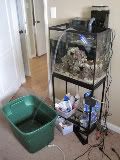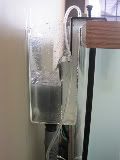 One part of my action plan included the addition of GFO (granular ferric oxide) media. I added a Two Little Fishies PhosBan Reactor 150 to the setup. I was pretty excited to get home and set the reactor up. Upon opening the box of the reactor, I was impressed with the simplicity of the setup. The instructions in the box were detailed and easy to follow. The reactor had only a few pieces, and was no trouble to assemble.
One part of my action plan included the addition of GFO (granular ferric oxide) media. I added a Two Little Fishies PhosBan Reactor 150 to the setup. I was pretty excited to get home and set the reactor up. Upon opening the box of the reactor, I was impressed with the simplicity of the setup. The instructions in the box were detailed and easy to follow. The reactor had only a few pieces, and was no trouble to assemble.I purchased a Maxi-Jet 600 to feed water to the reactor. The MaxiJet is a great little power head with seemingly endless possibilities, and I was impressed with all the attachments and adapters included with the pump. Maxi-Jet power heads are simply awesome, and I can’t stress that although many consider them old technology, they are strong pumps, they are extremely versatile, and they are very affordable.


A great benefit of the Two Little Fishies PhosBan reactor is the options you get with one reactor. The media reactor is flexible; you can use it for GFO, activated carbon, or even NPX Bio Plastics* (*with the addition of the screen adapter). The reactor is compatible with many pumps as long as you use the included ball valve to adjust the flow for the media you are using (you shouldn’t mix medias in one reactor). In fact, the Maxi-Jet I purchased is overpowered for this reactor, and it may come in handy if I choose to run carbon instead of GFO media. I wouldn’t mind purchasing another reactor for activated carbon as well, and I am itching to run NPX Bio Plastics in the future.

 The installation of the reactor was simple. All you need to do is assemble the inner components and adjust the sponge, add the media (I’m using Two Little Fishies PhosBan), connect the tubes and pump, and plug it in. The process only took a few minutes, and now my fish system is ready to reap the benefits of a GFO media reactor. I used 1/2 inch clear vinyl tubing, and forced it onto the maxi-jet outlet (which is 5/8 inches). I heated some water in the microwave for two minutes, put the end of the tubing in the hot water for about a minute, and then slipped the tubing right over. The included hose clamp holds the tubing in place on the Maxi-jet. The reactor can be mounted on the back of an aquarium, outside a sump, or even inside a sump. I installed my reactor by hanging it on the edge of the sump, but with the reactor body sitting inside the sump. This is a simple precaution to prevent and overflows due to leaks in the reactor. I’d rather be safe than sorry.
The installation of the reactor was simple. All you need to do is assemble the inner components and adjust the sponge, add the media (I’m using Two Little Fishies PhosBan), connect the tubes and pump, and plug it in. The process only took a few minutes, and now my fish system is ready to reap the benefits of a GFO media reactor. I used 1/2 inch clear vinyl tubing, and forced it onto the maxi-jet outlet (which is 5/8 inches). I heated some water in the microwave for two minutes, put the end of the tubing in the hot water for about a minute, and then slipped the tubing right over. The included hose clamp holds the tubing in place on the Maxi-jet. The reactor can be mounted on the back of an aquarium, outside a sump, or even inside a sump. I installed my reactor by hanging it on the edge of the sump, but with the reactor body sitting inside the sump. This is a simple precaution to prevent and overflows due to leaks in the reactor. I’d rather be safe than sorry.The Two Little Fishies Phosban Reactor is versatile, easy to set up, and will provide many benefits to my aquarium and my aquarium's inhabitants. The reactor, with GFO media, is expected to keep phosphate levels at zero, and hopefully it can help me tackle this Dino problem. Until next time...



 Working in the marine aquarium industry has some amazing perks! Yes, I get to talk about something I enjoy all day with customers, and I get to work with a bunch of other "fish nerds." More importantly, though, I get to hear about and see new products. Sometimes, I even get to play with them! This week I was allowed to take home and test a Current-USA TrueLumen Pro LED Strip. I brought home the 36" TrueLumen Pro LED Strip Light, Deepwater Actinic Blue 453nm. The Specifications from the manufacturer (
Working in the marine aquarium industry has some amazing perks! Yes, I get to talk about something I enjoy all day with customers, and I get to work with a bunch of other "fish nerds." More importantly, though, I get to hear about and see new products. Sometimes, I even get to play with them! This week I was allowed to take home and test a Current-USA TrueLumen Pro LED Strip. I brought home the 36" TrueLumen Pro LED Strip Light, Deepwater Actinic Blue 453nm. The Specifications from the manufacturer ( The LED is BRIGHT. I tried to take some pictures, but apparently my photography skills have failed me. It's difficult to capture the intensity of the lighting and accurately compare the brightness to that of my t-5 lighting.
The LED is BRIGHT. I tried to take some pictures, but apparently my photography skills have failed me. It's difficult to capture the intensity of the lighting and accurately compare the brightness to that of my t-5 lighting. 












 I downgraded to a much more manageable 8 gallon biocube as I figured the maintenance would be much more manageable. It was easier to preform water changes and I was able to keep some soft corals and some small fishes. The tank did well but crashed during the summer months, and rebounded after. It was easier to preform water changes (up to this point, I am purchasing saltwater from LFS's). Difficulty finding replacement bulbs and my displeasure with the DIY modifications to the hood (i purchased the tank used) left me feeling uneasy with the aquarium, so I purchased a light fixture and a 10 gallon aquarium and made the move. This aquarium survived and thrived, but getting RO/DI water and saltwater from my LFS was getting harder and hard with my schedule.
I downgraded to a much more manageable 8 gallon biocube as I figured the maintenance would be much more manageable. It was easier to preform water changes and I was able to keep some soft corals and some small fishes. The tank did well but crashed during the summer months, and rebounded after. It was easier to preform water changes (up to this point, I am purchasing saltwater from LFS's). Difficulty finding replacement bulbs and my displeasure with the DIY modifications to the hood (i purchased the tank used) left me feeling uneasy with the aquarium, so I purchased a light fixture and a 10 gallon aquarium and made the move. This aquarium survived and thrived, but getting RO/DI water and saltwater from my LFS was getting harder and hard with my schedule.  I topped off using tap water (carbon filtered, but still tap water) and the water changes were far and few between. The tank developed algae problems and eventually declined. The aquarium also developed a leak, so I knew it was time to change. I was also in the progress of painting, so it was a perfect time to 1) break down my freshwater aquarium, 2) move the nano reef, and 3) convince myself that it was time to upgrade. The reef itch (a very contagious and often incurable disease) struck...
I topped off using tap water (carbon filtered, but still tap water) and the water changes were far and few between. The tank developed algae problems and eventually declined. The aquarium also developed a leak, so I knew it was time to change. I was also in the progress of painting, so it was a perfect time to 1) break down my freshwater aquarium, 2) move the nano reef, and 3) convince myself that it was time to upgrade. The reef itch (a very contagious and often incurable disease) struck...